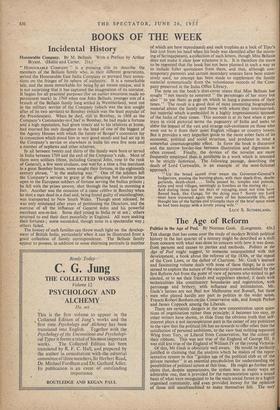BOOKS OF THE WEEK
Incidental History
Honourable Company. By M. Bellasis. With a Preface by Arthur Bryant. (Hollis and Carter. 21s.)
" HONOURABLE COMPANY " is a punning title to describe the members of the Bellasis family who, in their different generations, served the Honourable East India Company or pursued their avoca- tions on the fringes of its sphere of authority. It is a remarkable tale, and the more remarkable for being by no means unique, and it is not surprising that it has captured the imagination of its narrator. It begins for all practical purposes (for an earlier excursion made no permanent mark) in 1769 when one John Bellasis, younger son of a branch of the Bellasis family long settled in Westmorland, went out in the military service of the Company (which was the less sought after of its two services) to Bombay (which was the least popular of the Presidencies). When he died, still in Bombay, in 1808 as the Company's Commander-in-Chief in Bombay, he had made a fortune and a high reputation, had given timely aid to his relatives at home, had married his only daughter to the head of one of the biggest of the Agency Houses with which the future of Bengal's commerce lay (a connection which stood him in very good stead) and had set up in the Company's service or elsewhere in India his own five sons and a number of nephews and other relatives.
In all between twenty and thirty of the family were born or served in India between 1769 and the end of the Company's rule. Most of them were soldiers (three, including General John, rose to the rank of General), a few were civilians, one was for a time a free merchant in a great Bombay house, some sought their fortune, in the eighteenth century phrase, " in the seafaring way." One of the soldiers left the Company's service to grasp at the glittering but elusive prizes open to the European soldiers of fortune serving the Indian princes ; he fell with the prizes unwon, shot through the head in storming a fort. Another was the occasion of a cause alebre in Bombay when he shot a man dead in a duel and, being found guilty of manslaughter, was transported to New South Wales. Though soon released, he was only reinstated after years of petitioning the Directors, and the exercise of all the influence of General -John and his powerful merchant son-in-law. Some died young in India or at sea ; others returned to end their days peacefully in England. All were seeking their fortunes ; some succeeded, though none in a spectacular way ; others failed.
The history of such families can throw much light on the develop- ment of British India, particularly when it can be illustrated from a good collection of family correspondence. The Bellasis family appear to possess, in addition to some charming portraits (a number of which are here reproduced) and such trophies as a lock of Tipti's hair (cut from his head when his body was identified after the storm ing of Seringapatam), a collection of such letters, though Miss Bellasis does not make it clear how extensive it is. It is therefore the more to be regretted that the book has not been planned in such a way as to include fuller quotations from them, and that, although con- temporary pemoirs and certain secondary sources have been exten- sively used, no attempt has been made to supplement the family material systematically from the voluminous records of the .Corn pany preserved in the India Office Library.
The note on the book's dust-cover states that Miss Bellasis ha! sought " not merely to resurrect " the personages of her story but also " to use them as pegs on which to hang a panorama of theil times." The result is a good deal of most interesting biographical material about the family and those with whom they intermarried but material which is embedded in a highly impressionistic account of the India of their times. This account is at its best when it por trays in vivid pictorial terms the pageantry of India and seeks tc show the impact of the vast and strange sub-continent on those whc went out to it from their quiet English villages or country towns But it provides a very imperfect guide to the more sober facts of it economic, political and social structure, and produces in total t somewhat cinematographic effect. In form the book is discursive and the narrow border-line between illustration and digression often crossed. Finally, the devices of the novelist are more frequently employed than is justifiable in a work which is intended to be strictly historical. The following passage, describing the death of Lord Cornwallis, is an example of the semi-fictiona approach :
" Up the broad sacred river swam the Governor-General's
budgerows, passing the burning-ghats, with their death-fires, death•
garlands, death-chant India passed by, temples and palaces, ruins and mud villages, seemingly as limitless as the staring sky And during those last ten days of voyaging, must not time have flowed back, like Gunga, for the dying man ? Surely my Lord must have traversed again the years of his honourable life, and thought less of the battles and triumphs than of the brief space whet he had been happy with a lovely young wife."
LUCY S. SUTHERLAND.


































 Previous page
Previous page